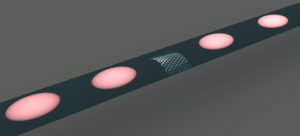Single-photonics on a Chip
In a potential boost for quantum computing and communication, a European research collaboration reported a new method of controlling and manipulating single photons without generating heat. The solution makes it possible to integrate optical switches and single-photon detectors in a single chip. Publishing in Nature Communications, the team reported to have developed an optical switch that is reconfigured with microscopic mechanical movement rather than heat, making the switch compatible with heat-sensitive single-photon detectors. The new method enables control of single photons without the disadvantage of heating up a semiconductor chip and thereby rendering single-photon detectors useless. Using microelectromechanical (MEMS) actuation, the solution enables optical switching and photon detection on a single semiconductor chip while maintaining the cold temperatures required by single-photon detectors.

Reconfigurable photonics with on-chip single-photon detectors
S. Gyger, et al., Nature Communications 12, 1408 (2021). Link; Coverage: KTH Press Release, European Commission, phys.org, EurekAlert;
Nanomaterials for energy applications
The group led by Muhammet Toprak develops thermoelectric nanomaterials to harvest waste thermal energy in the surrounding and convert into electrical power. The group recently developed an ink/paint formulation using a combination of green-chemical synthesis, surface-interface engineering, and additive manufacturing strategies [1]. The developed paint can be coated on the surfaces generating heat, enabling locally generated heat that can be used to power some other tools. The group exploits the implementation of this paint concept for harvesting body-heat to power wearable electronics, sensors, and low-power applications in the internet of things (IoT).

[1] J. F. Serrano-Claumarchirant et al., “Thermoelectric Inks and Power Factor Tunability in Hybrid Films through All Solution Process,” ACS Appl. Mater. Interfaces, vol. 14, pp. 19295–19303, 2022. DOI
Press release on this milestone at KTH-web, covered in national and international news: KTH: nyheter, FORSKNING.SE, AZOM.COM, SWIPENEWS
High-power THz Generation
We have demonstrate multi-cycle terahertz (MC-THz) generation in periodically poled rubidium (Rb)-doped potassium titanyl phosphate (Rb:PPKTP) crystal. The maximum internal optical-to-terahertz conversion efficiency achieved is comparable with results achieved using periodically poled lithium niobate crystals. Neither photorefractive effects nor damage was observed with up to 1 J/cm^2, showing the great potential of Rb:PPKTP for multi-millijoule-level MC-THz generation.

Record high THz energy demonstrated with Rb:KTP crystals
W. Tian, et al., “mJ-level multi-cycle terahertz generation in a periodically poled Rb:KTP crystal”, Optics Letters 46, 741-744 (2021).
Intermodulation Products
KTH-ANL hosts the biggest and most versatile atomic force microscopy (AFM) lab in Sweden. Thanks to this rich and flexible environment, Intermodulation Products AB was founded as a spinoff of the Haviland group (KTH-APhys). Intermodulation Products AB commercializes add-on equipment to labs and users who want to extend the measurement capabilities of their AFM with mechanical, electrical and magnetic characterization, for applications ranging from energy materials to life sciences. All the special modes developed by Intermodulation Products are available to users of the KTH-ANL AFMs. The start-up is actively expanding its products space, e.g. to high-speed multi-frequency lock-in systems.

Comparison of Intermodulation EFM and KPFM by users of AFM-ANL. Maps and histograms of work function in volts measured on graphene monolayer (blue) with flakes of bilayer graphene (yellow). Graphene is thermally grown on silicon carbide (SiC) substrate. White scale bars are 3 μm. From R. Borgani, PhD Thesis, KTH 2018.
Single Quantum
Single Quantum, a spinoff from the Zwiller group (KTH-APhys), commercializes high-performance single-photon detectors based on superconducting nanostructures. The outstanding superconducting film deposition and nano-patterning processes available at KTH-ANL enable joint R&D of KTH and Single Quantum on developing a new generation of single-photon detectors with the time resolution, noise level, and detection efficiencies setting new standards in quantum optics [1]. The application space is the booming quantum communications, where SQ is one of the fastest growing start-ups internationally.

[1] J. Zichi, J. Chang, S. Steinhauer, K. von Fieandt, J. W. N. Los, G. Visser, N. Kalhor, T. Lettner, A. W. Elshaari, I. E. Zadeh, and V. Zwiller, “Optimizing the stoichiometry of ultrathin NbTiN films for high-performance superconducting nanowire single-photon detectors”, Opt. Express 27, 26579 (2019).
Figure main panel: top view of superconducting NbTiN meander-patterned single-photon detector; top-left: meander-nanowire close-up; bottom-right: detector integrated with optics.
Integrated Single Photon Emitters
The promise of a quantum internet depends on the complexities of harnessing light to transmit quantum information over fiber optic networks. A potential step forward was reported today by researchers at KTH who developed integrated chips that can generate light particles on demand and without the need for extreme refrigeration.
(from KTH&WACQT press release)

Deterministic Integration of hBN Emitter in Silicon Nitride Photonic Waveguide
Ali W. Elshaari*, Anas Skalli*, Samuel Gyger, Martin Nurizzo, Lucas Schweickert, Iman Esmaeil Zadeh, Mikael Svedendahl, Stephan Steinhauer, Val Zwiller, Advanced Quantum Technologies 4, 2100032 (2021) * Equal contribution; Selected as Journal cover page
Wiley Journal article